The Samsung 850 EVO 4TB SSD Review
by Billy Tallis on July 11, 2016 10:00 AM ESTRandom Read Performance
The random read test requests 4kB blocks and tests queue depths ranging from 1 to 32. The queue depth is doubled every three minutes, for a total test duration of 18 minutes. The test spans the entire drive, which is filled before the test starts. The primary score we report is an average of performances at queue depths 1, 2 and 4, as client usage typically consists mostly of low queue depth operations.
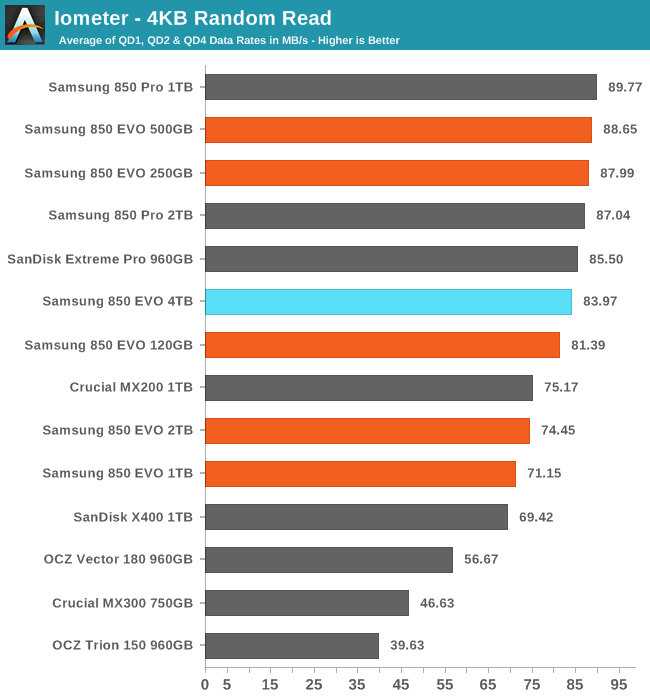
Random read performance of the 4TB 850 EVO is substantially better than the 1TB and 2TB 850 EVOs, but still not quite as fast as the best MLC drives or the 500GB and 250GB 850 EVOs.

The power consumption of the 4TB 850 EVO is slightly higher than the 2TB model, but overall the efficiency is improved over the smaller drive with the same controller but older NAND.
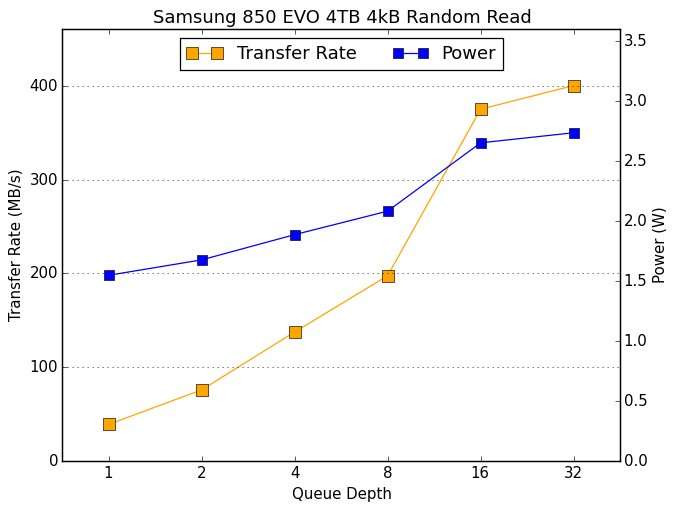 |
|||||||||
The scaling behavior of the 4TB 850 EVO is almost identical to the 2TB model, just with slightly higher performance and power consumption across the board.
Random Write Performance
The random write test writes 4kB blocks and tests queue depths ranging from 1 to 32. The queue depth is doubled every three minutes, for a total test duration of 18 minutes. The test is limited to a 16GB portion of the drive, and the drive is empty save for the 16GB test file. The primary score we report is an average of performances at queue depths 1, 2 and 4, as client usage typically consists mostly of low queue depth operations.
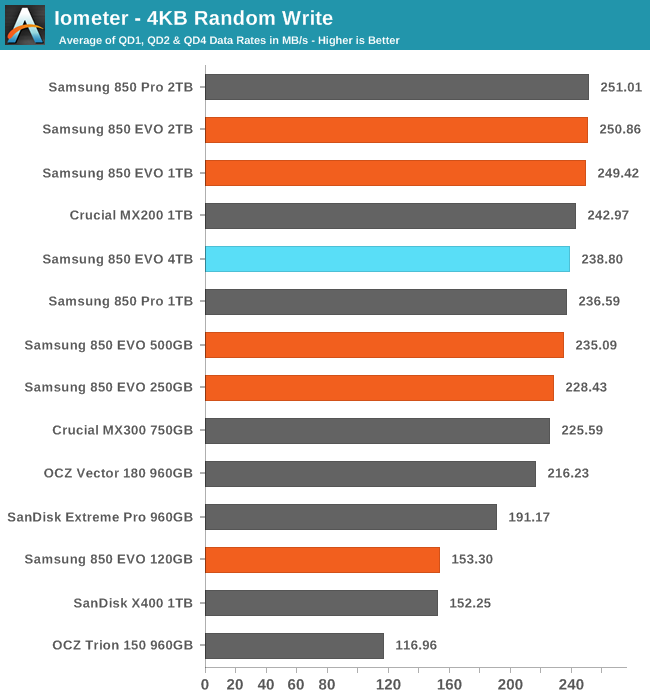
Random write speed for the 4TB 850 EVO is a little bit slower than for the 1TB and 2TB models, but still fast enough to beat almost all non-Samsung drives.
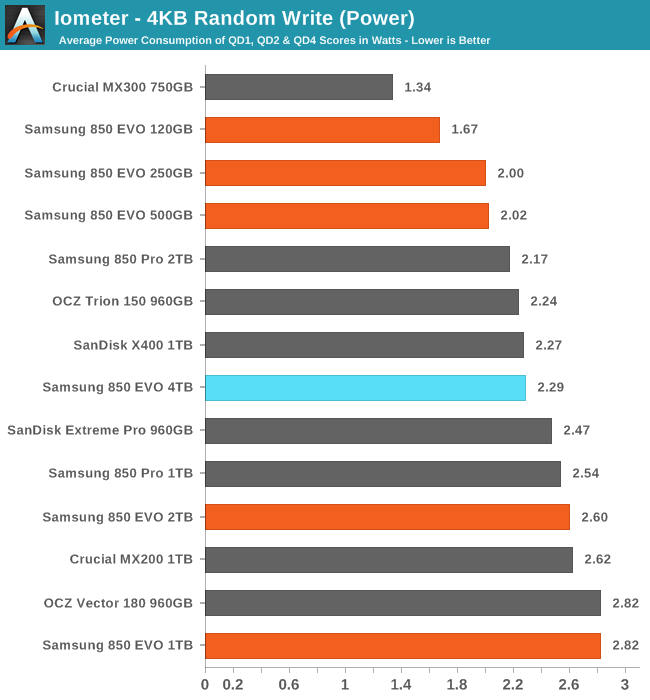
Power consumption of the 4TB 850 EVO is substantially better than the 1TB and 2TB counterparts, making it one of the most efficient large drives. The 750GB Crucial MX300 was still much more efficient.
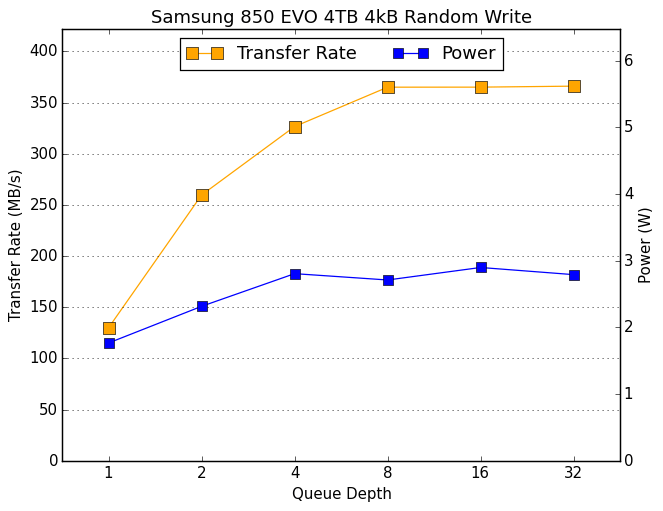 |
|||||||||
The lower performance score for the 4TB was apparently due to a regression in QD4 performance, where the 1TB and 2TB models were able to reach full speed but the 4TB needs a larger queue.










145 Comments
View All Comments
Lolimaster - Tuesday, July 12, 2016 - link
If you "work" with 4k raw videos you can afford the enterprise level SSD's with their multi petabyte endurance rating.mapesdhs - Wednesday, July 13, 2016 - link
Exactly. I know someone who's been testing 8K editing at a movie company, he was able to get over 8GB/sec from a good Enterprise PCIe device, with consistent performance being absolutely critical. He did try RAIDs of 850 Pros but they just couldn't handle it.AnnonymousCoward - Monday, July 11, 2016 - link
Look at the graph on this page...the Samsung showed bad sectors 4 times earlier than the others: http://techreport.com/review/27909/the-ssd-enduran...3 things matter to me with SSDs: cost, reliability, and UX performance.
DPUser - Monday, July 11, 2016 - link
That was 2-D TLC. The 850 uses much more robust 3-D NAND.AnnonymousCoward - Tuesday, July 12, 2016 - link
I guess we need updated data then :)ddriver - Monday, July 11, 2016 - link
Well, that's the 840 pro - old stuff... Also, it is possible that samsung have more strict criteria of when a sector becomes unreliable and requires reallocation.Palorim12 - Tuesday, July 12, 2016 - link
But in the end, didn't the 840 Pro outlast all the other drives?hojnikb - Monday, July 11, 2016 - link
That endurance rating is simply for segmentation purposes. In reality, drive should easily reach 4PB+ of writes, before crapping out.mdw9604 - Tuesday, July 12, 2016 - link
Can you explain? I'd like to buy one for a project I am working on, if this is true.mdw9604 - Tuesday, July 12, 2016 - link
I agree. I know its EVO...but write endurance on a drive that expensive is pretty bad.